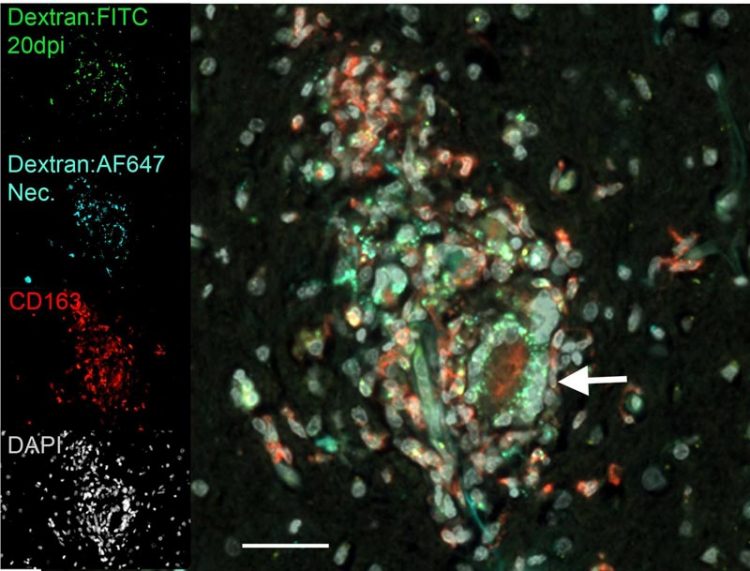Study shows role of disease-fighting cells in HIV-related neurological damage

Dyes illuminate macrophage and monocyte cells as they arrive in the brain, where their presence is tied to neurological damage in people otherwise living symptom-free with HIV. By using different colored dyes to tag these disease-fighting cells, researchers have developed a clearer picture of how and when macrophages and monocytes accumulate in different parts of the brain during stages of HIV infection and the onset of AIDS. The findings, reported in the American Journal of Pathology, add new evidence about the role of these cells in AIDS-related dementia and other illnesses. Credit: Amer. Journal of Pathology
Despite symptom-stifling anti-retroviral drugs, as many as half of all patients living with HIV experience neurological damage tied to chronic inflammation in the brain fueled by the body's own immune defenses.
In an effort to understand why patients who appear virus free are afflicted with AIDS-related dementia and other illnesses, researchers have focused on disease-fighting cells, called macrophages and monocytes, as they traffic throughout the body and into the brain.
But little has been known about the timing and dynamics behind these types of white blood cells as they invade the central nervous system during the initial stages of HIV infection or at the onset of AIDS.
A new investigative approach in SIV-infected rhesus monkeys has yielded fresh clues that show the caustic interplay between macrophage and monocyte traffic in the central nervous system and the onset of HIV infection and the formation of brain lesions tied to neurological damage, according to a new report in the online edition of the American Journal of Pathology.
Researchers from Boston College, the University of Florida and Tulane University Health Science Center report macrophages accumulate in different parts of the brain during different stages of initial infection, a finding that clarifies the spread of infection to the brain is a multi-layered and dynamic process.
“This type of approach allowed us to label macrophages in the perivascular space in the brain to identify macrophage and monocyte traffic to the brain in the early, mid and late stages of infection,” said Boston College Professor of Biology Kenneth Williams, the senior author of the report. “We now know what cells bring the virus to the brain and what cells contribute to neurological damage in the brain, as well as the timing of the entry of these cells and when the pathologic virus enters. These are two big questions researchers have had.”
The researchers tagged monocytes, destined to enter the brain, in bone marrow with a biochemical marker known as BrdU and also used a series of different color dyes to label macrophages as they entered the central nervous system at different times in infection, including early, mid and terminal states. As infection progressed, the researchers found MAC387 macrophages accumulated in the meninges and choroid plexus in early-stage brain infection. Later on, MAC387 macrophages were found in perivascular spaces that surround arteries and veins in the brain, as well as at sites where brain lesions would form.
Another macrophage, known as CD163 macrophages, was traced to perivascular space and brain lesions during the late stage, the team reports. Late in infection, the volume of macrophages entering the brain was nearly three times as great as during early-stage infection.
“An important question researchers have is what drives the pathology and the resulting damage in the brain?” said Williams. “Is it the virus itself or macrophage and monocyte cells? What we found is that these cells that arrive late with the development of AIDS have a 2.9-fold higher percentage of being infected with the virus. So there is a dramatic increase in the viral load as infection progresses that correlates to macrophage accumulation.”
Turning their attention to lesion formation, the researchers discovered that greater than 80 percent of the macrophages found in the lesions were present in the brain prior to lesion formation. The surprising finding suggests the cells in the lesions migrated from non-lesion sites in the brain rather than from outside the brain.
“Brain lesions are central to understanding what causes AIDS-related dementia,” said Williams. “In early stages of infection, we could see two or three macrophages scattered along the vessel. By the late stage, when lesions appeared, there were 30 to 50 at the site. What we found is that a majority of the cells in the lesions were present in the brain at an early stage. So these macrophages are migrating from the brain to the lesion sites, which shows a complex and dynamic level of activity.”
Media Contact
All latest news from the category: Life Sciences and Chemistry
Articles and reports from the Life Sciences and chemistry area deal with applied and basic research into modern biology, chemistry and human medicine.
Valuable information can be found on a range of life sciences fields including bacteriology, biochemistry, bionics, bioinformatics, biophysics, biotechnology, genetics, geobotany, human biology, marine biology, microbiology, molecular biology, cellular biology, zoology, bioinorganic chemistry, microchemistry and environmental chemistry.
Newest articles

A ‘language’ for ML models to predict nanopore properties
A large number of 2D materials like graphene can have nanopores – small holes formed by missing atoms through which foreign substances can pass. The properties of these nanopores dictate many…

Clinically validated, wearable ultrasound patch
… for continuous blood pressure monitoring. A team of researchers at the University of California San Diego has developed a new and improved wearable ultrasound patch for continuous and noninvasive…

A new puzzle piece for string theory research
Dr. Ksenia Fedosova from the Cluster of Excellence Mathematics Münster, along with an international research team, has proven a conjecture in string theory that physicists had proposed regarding certain equations….



